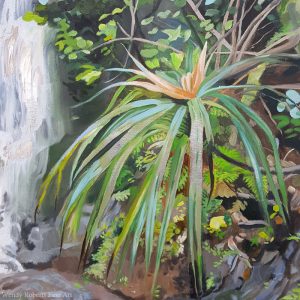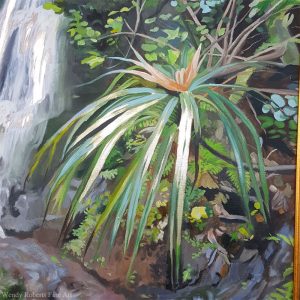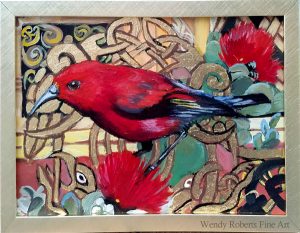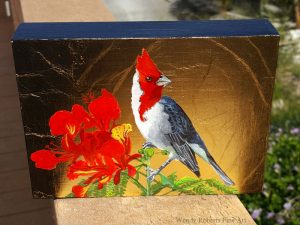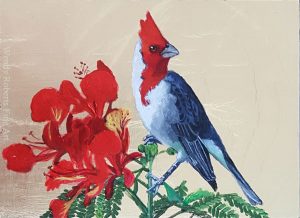From March 2015:
“I am turning over a new “leaf” with a new series. I am working on adding precious metals to my work. I’ve been reading up exhaustively on the age-old methods of gilding and painting on copper. I have always loved the old elaborate works from Italy in the 1500s, from artists such as Fra Angelico, and likewise, the beauty of impressionist landscape. I have wondered in the past what it would look like if the old illuminated manuscripts were made in a tropical location, and it has spurred me to make a new series, tropical illumination. I plan to paint the beautiful landscapes of Hawaii with the beautiful metals of an earlier time.”
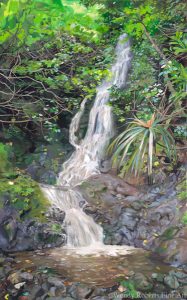 I found this little paragraph in my drafts from 2015 and thought it was a good tidbit of “thought-history” to share. I have since acted on this idea and learned to use metal leaf.
I found this little paragraph in my drafts from 2015 and thought it was a good tidbit of “thought-history” to share. I have since acted on this idea and learned to use metal leaf.
What I had in mind was an array of results. I’m going to do the exact opposite of what I probably should do and reverse the countdown to share my favorite one first. This realistic landscape, Sacred Space, with just a touch of subtle leafing in the water and leaves (my favorite use of leafing to date) really catches the eye with movement as it shifts and reflects the lighting. At night it softly reflects any lights in the vicinity, remaining interesting to look at when other paintings have ceased to be visible.
The whimsical metal leafing celtic-type manuscript bird painting below with an apapane and ohia woven into the image is probably the closest to the source of what inspired me to start using metal leaf. The Secret of Kells – a gorgeous animation featuring the beautiful illuminated manuscripts of Kells was the spark for me that led to learning how to leaf. The story within the animation is fictional, and full of fairy folk and charm, but the book is real and so is the heart of the message within the movie. It’s gentle in spirit and stunningly beautiful! I highly recommend it. This animation made me think of the beauty of the illuminated manuscripts, and I began to wonder what monks from Ireland would have painted they would have seen Hawaii. This is a visual combination between the Celtic style and realism. The monks would have translated the bird and the ohia into their imaginative style, but I wanted to have a play between the two worlds. Busy and intricate celtic knotwork featuring birds is leafed on top of adaptations from a page from a celtic manuscript that weaves around the realistically painted apapane and ohia that intertwines decoratively with the realistic bird and flower. This endangered bird and the iconic flower of Hawaii that provides its habitat, are more rare than jewels (and just as colorful). Here they are treated like precious treasures – illuminated like the most important words of an ancient world.
Sometimes it’s nice to paint a bird in front of a simple background of metal leaf like this copper/zinc leafing surrounding the red crested cardinal. The leafing is allowed to show off the interesting ripples that run through this particular type of leaf. Here I have shown the piece in two drastically different lighting schemes. I love the life that metal gives to the piece – constantly affected by the surroundings. Sometimes it is hard to do it justice in a photo.
In this last painting below, I was looking to Jesse Arms Botke, an amazing decorative painter during the turn of the century, as my inspiration. Here, I am using the copper leafing as a major feature of the surroundings. The copper leaf in this painting took on a patina before sealing. I utilized the natural variations in tone from green to coppery orange to create the effect of a shallow pond (actually a loi – a Hawaiian taro garden flooded with water)
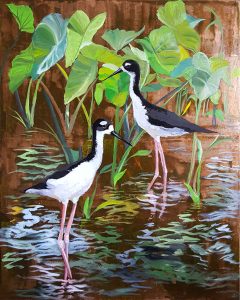 I am continuing to explore the realm of metal leafing both in oil and in water-based works. With different sizing and sealants, I can work with metal in either media. It is very exciting to see what it can add to artistic creativity. It can go under or over paint, and multiple metals can be used in the same piece. It produces a piece that cannot be replicated by a camera, which is a major bonus in my opinion, I love the light and movement it imbues into artwork. I use it judiciously in some but not all of my pieces.
I am continuing to explore the realm of metal leafing both in oil and in water-based works. With different sizing and sealants, I can work with metal in either media. It is very exciting to see what it can add to artistic creativity. It can go under or over paint, and multiple metals can be used in the same piece. It produces a piece that cannot be replicated by a camera, which is a major bonus in my opinion, I love the light and movement it imbues into artwork. I use it judiciously in some but not all of my pieces.
